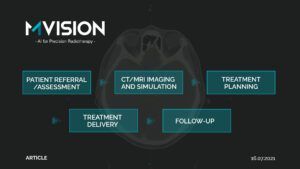Did you know that more than 60% of cancer patients will receive radiation therapy, a local treatment that is based on the use of ionizing radiation to cause damage to tumor cells and prevent the growth and proliferation, at some point in the treatment? The quality and atmosphere of radiotherapy treatment not only affects healthcare professionals and cancer patients, but also the friends and family of the patients and medical professionals. In this article we will further explain radiotherapy workflow, including its importance and inner workings, and provide a helpful solution to ease the radiotherapy workflow.
What is the radiotherapy process?
Radiotherapy is the branch of medicine that deals with the treatment of cancer by delivering high-energy beams directly to a tumor, or intended target. The primary goal of radiotherapy is to control the growth of the tumor, while minimising exposure to any healthy tissue in the surrounding area. The radiation caused by radiotherapy damages the DNA in cancer cells, obstructing cell reproduction. This in turn, causes the cancer cells to die and the tumor to shrink. One of the many benefits of radiotherapy is that the treatment sessions are typically given on an outpatient basis, meaning no hospital stay is required.
Why is the radiotherapy process Important?
Approximately 39.5% of men and women will be diagnosed with cancer. Additionally, about 1 in every 6 people diagnosed with cancer has had a different type of cancer in the past. Cancer not only takes a toll both on the overall wellness and finances of patients. In 2018, in the US alone, patients spent $5.6 billion in out-of-pocket costs for cancer treatment. Fortunately, radiotherapy is highly successful. 4 out of every 10 cancer cures include radiotherapy as part of the treatment plan. The number of radiation-treated cancer survivors is projected to reach 4.17 million by 2030. Quite simply, taking into account the amount of people affected by cancer and success of cancer cure rates from radiotherapy, radiotherapy and the radiotherapy process is extremely important.
How does the radiotherapy process work?

The first step in the radiotherapy process is the patient referral and assessment.
Patients may attend an appointment with a radiation oncologist, who reviews a patient’s medical records, pathology reports and radiology images and performs a physical examination. If the oncologist decides radiotherapy treatment is the best option, the patient will be asked to book an appointment for a simulation.

Next, the patients will undergo the CT/MRI imaging and simulation process, allowing the radiation oncologist to define the exact location and configuration of the treatment for your cancer or tumor.
The radiation oncology department will take X-rays or CT scans (and a MRI or PET, if needed), sometimes using a contrast agent to improve the quality of information. Occasionally, the patients’ cancerous areas will need to be marked with a tiny, tattoo dot to ensure that the radiation is directed properly.

Then, the treatment planning process begins, and can often take several days. Radiation oncologists, medical physicists, and dosimetrists work together, using the CT scan images (and a MRI or PET, if needed), to design the patients’ radiation therapy treatment plan.
The primary goal is to deliver a high dose of radiation to the tumor, while preserving the normal, healthy tissue around the tumor. The treatment plans are very complex and personal, customized for each patient.

After that, the radiotherapy treatment delivery process is ready to begin.
On the first day of treatment, the radiation therapist positions the patient, places them in immobilization devices, and delivers the radiation dose prescribed by the radiation oncologist. Images are often taken on the first day of treatment and at regular intervals to confirm that the area of the body being treated has not changed position. The individual duration of each radiotherapy treatment session typically lasts for less than 20 minutes
.
Once the radiotherapy treatment has concluded, patients will attend a follow-up appointment to monitor the recovery and overall health of patients.
Additional diagnostic tests may be ordered. Reports on the status of our patients are sent to all physicians involved in patient care. As time goes by, the frequency of visits decreases.

Solution
Although the radiotherapy process is quite complex, there is a solution available to help improve the lives of both the patient and the oncology team. MVision AI is proud to provide a guideline-compliant, deep-learning tool that automates segmentation in radiotherapy to streamline cancer treatment planning. To stay up-to-date on the latest news and information, visit our website or follow us on LinkedIn.
For more information on our services, contact MVision AI:
c/o Terkko Health Hub, Haartmaninkatu 4, 00290 Helsinki, Finland.
Tel: +358 (0) 40 5489 229
Email: info@mvision.ai
For media inquiries
Tel: +358 40 500 7915
Email: pr@mvision.ai
Sources
“What Is a Second Cancer?” Cancer.Net, 29 May 2020, www.cancer.net/survivorship/what-second-cancer.


